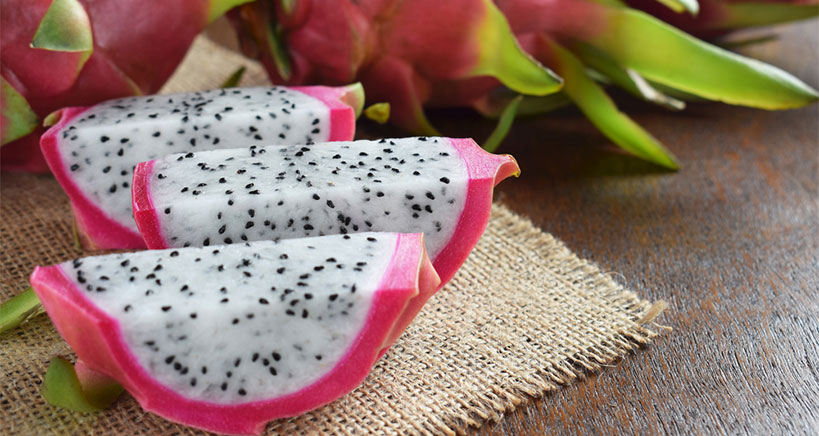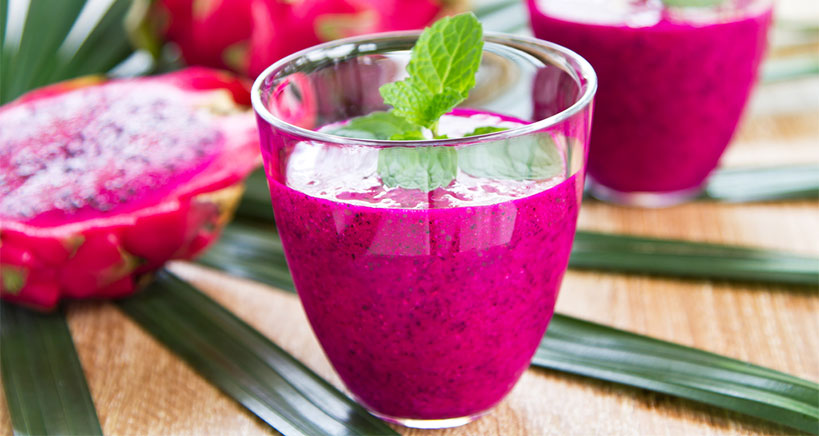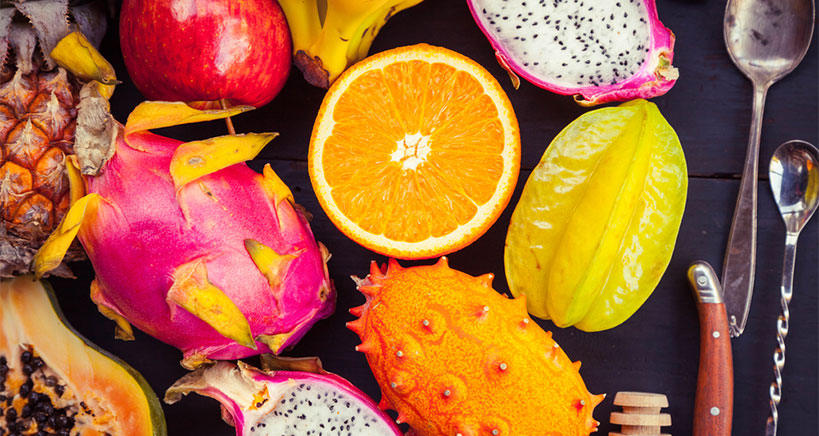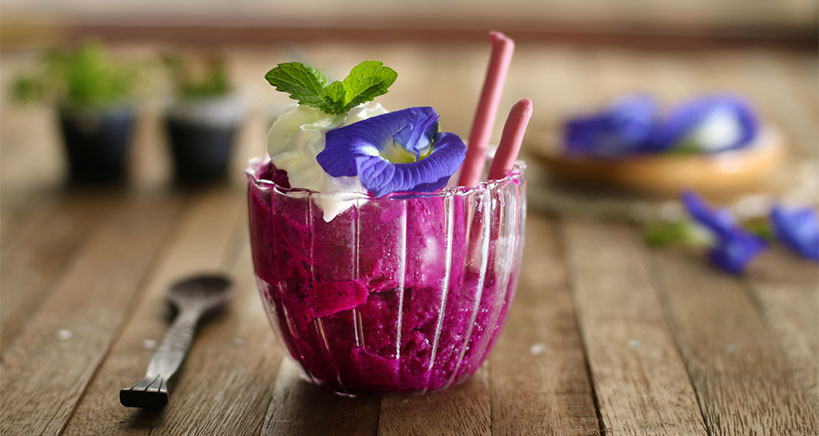
Attention all Foodservice Professionals! If you are looking for a business-booster and menu game-changer, set your sights on what is promising to be a rising star in the food-and-beverage industry: Dragon Fruit.
Even if you have never heard of dragon fruit before or have never prepared a dragon fruit recipe, now is the time to get on board because as this standout ingredient continues to gain traction in the U.S. and abroad, this is one business opportunity you do not want to miss out on.
So take a load off your feet, clear your trays, and prepare your palates for the full scoop on one of the coolest, strangest-looking, nutritious, and delicious tropical fruits on the planet.
Adventurous Consumers Love Dragon Fruit
If you work in the biz, you know that today’s daring diners are hungry for exciting and exotic tastes, for foods and beverages from around the world, and for ingredients with a wow factor. Moreover, they are willing to pay top-dollar at restaurants and food venues that provide them with unique experiences and dishes that they can post on Instagram and share online.
If ‘off-the-wall’ and ‘off-the-charts’ are what your customers are clamoring for, you can easily satiate their appetite by introducing them to the enticing world of dragon fruit.
Dragon Fruit Gaining Global Steam
Native to Central America’s Costa Rico, dragon fruit’s presence is increasing on the global food scene and is now being grown in the tropic climates of Asia as well as in Florida and California in the United States. With health reports claiming it has superfood nutritional powers, savvy foodservice pros are paying attention and learning all they can about how to buy, prepare, and eat dragon fruit.
Fortunately, you no longer need to travel to the tropics to enjoy the fruit’s multiple benefits (nor do you have to slay a dragon!). It is currently available fresh or frozen in supermarkets worldwide, as well as in its dried form which is said to have up to ten-times the nutritional benefits of the fresh fruit. Whether you peel and eat it alone, use it as a garnish or decoration, or add it to fruit salads, cocktails, smoothies, sorbet, desserts, and even salsa, dragon fruit is clearly gaining traction. And in a dynamic milieu teeming with competitors, you have a rare opportunity to step out of the pack and be on the cusp of the future by featuring dragon fruit on your menu.

Dragon Fruit – How Does it Look?
What does dragon fruit look like? Since head-turning dishes are consumer magnets in modern-day foodservice, the very odd appearance of dragon fruit could be a business game-changer. Picture this: A large, mango-sized fruit from the cactus family that grows on a vine; a plant that looks like a soft pineapple with spikes, or a plant that has scale-like leaves like an artichoke, with a red, pink, or yellow exterior and white or magenta red flesh inside. It’s packed with small, black edible seeds, also bears a resemblance to kiwi, and its taste is mildly sweet like a pear. Finally, unlike a banana which is peeled, dragon fruit is sliced lengthwise or into quarters in order for the soft flesh inside to be removed and enjoyed.
User Beware, however: Like a beet, red dragon fruit (aka pitaya or strawberry pear), will color stain your hands, clothes, and anything else in its path.
Dragon Fruit Nutritional Value
Packing a powerful nutritional punch which makes it particularly popular among the growing population of health-conscious consumers, here are some evidence-based health benefits of dragon fruit:
- Low in calories, high in fiber and essential vitamins and minerals
- A one-cup (227 gram) serving contains: 136 calories; 3 grams protein; 0 grams fat; 7 grams fiber; 8% of the recommended daily intake (RDI) of iron; 18% of the RDI of magnesium; 9% of the RDI of vitamin C; 4% of the RDI of vitamin E
- Is a good source of antioxidants (betalains, polyphenols and ascorbic acid) which help fight off free radicals that can lead to chronic disease
- The high flavonoid content in red dragon fruit may help control glucose levels for people with Type 2 diabetes
- Contains prebiotics, which promote the balance of good bacteria in the gut and contribute to a healthy gastrointestinal tract
- Is one of the few fresh fruits containing iron and is a good source of magnesium, a nutrient responsible for over 600 bodily biochemical reactions including metabolism
Dragon Fruit Quick Facts
Hungry for more info? Here are some fascinating facts:
Starbucks recently debuted a dragon fruit drink for the summer.
Dragon fruit is also known as “lady of the night” or “moonflower” because the plant lives for only one night! At dusk, pink or yellow flowers are produced by a climbing cactus. At midnight, the flowers are pollinated by bats and moths. Right before dawn, the flowers wither and die.
Fortunately, the fruit at the base of the wilted flower continues to grow, reaching full size in about a month. And since each plant can pollinate at least 6 times a year, dragon fruit is available year-round.

Selecting and Storing Dragon Fruit
Here are some guidelines on selecting the perfect dragon fruit for your recipes: Green means unripe; multiple splotches means overripe; bright red means ‘good to go!’ Like buying a kiwi or avocado, the ideal ingredient should be soft but not mushy.
Alternatively, you can procure frozen dragon fruit for your restaurant or food venue, which typically comes pre-peeled and already cut into cubes. Moreover and very conveniently, thanks to advances in technology you can even purchase freeze-dried pitaya powder.
To store dragon fruit, refrigerate for up to three weeks in a sealed plastic bag or freeze for up to one year. You can also dry and preserve it yourself.
How to Eat Dragon Fruit
Most often eaten raw, there are several ways to extract the seeded white or red flesh from its colorful exterior and add it to recipes:
- Slice the fruit lengthwise, in half, or into small chunks to expose the seeded flesh. With a spoon, scoop the pulp directly from the rind, eat and enjoy. Note: Many people chill prior to eating
- Cut into cubes and add to fruit juice, yogurt, shakes, and power drinks
- Remove flesh with a melon baller, to yield fancy dragon fruit spheres to add to salads and other bowls
- Use the brightly colored outer shells as head-turning serving vessels
Adding Dragon Fruit to Dishes
Not sure how to add dragon fruit to your customers’ favorite dishes and desserts? Experiment with the following plateful of scrumptious ideas:
- Dragon Fruit Salad
- Dragon Fruit Smoothies topped with granola and fresh berries
- Dragon Fruit Pancakes
- Dragon Fruit Salsa in tacos
- Pitaya icings and frostings made with purred red dragon fruit
- Dragon Fruit popsicles (aka pitaya ice pops)

Recipe for Red Dragon Fruit Sherbet
And now what you’ve all been waiting for: Just in time for summer, a heavenly frozen dessert recipe featuring the one and only red dragon fruit.
Ingredients
- 2 cups cubed red dragon fruit
- 1 cup cubed honeydew melon
- 3/4 cup sugar
- 1 tsp. vanilla
- 1 cup half-n-half cream
Instructions
- Place all ingredients in a food processor bowl
- Process until smooth and the sugar is dissolved
- Whisk in the cream
- Chill for at least two hours or overnight
- Transfer sherbet to a freezer-safe container. Freeze for at least one hour before serving.
- 2 cups frozen cubed dragon fruit
- 1/3 cup plain yogurt
- Blend all ingredients in a food processor or blender
- Freeze
- Add toppings of your choice
- Enjoy!
Tropical Fruit Dragon Smoothie Bowl
Finally, here is one more super-easy-to-prepare recipe for you and your customers to relish.
Ingredients
Instructions
I love all the education about dragon fruit. It’s very helpful